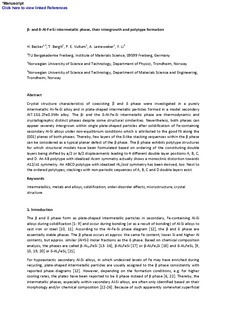| dc.contributor.author | Becker, Hanka | |
| dc.contributor.author | Bergh, Tina | |
| dc.contributor.author | Vullum, Per Erik | |
| dc.contributor.author | Leineweber, Andreas | |
| dc.contributor.author | Li, Yanjun | |
| dc.date.accessioned | 2020-02-07T14:28:16Z | |
| dc.date.available | 2020-02-07T14:28:16Z | |
| dc.date.created | 2018-12-12T11:11:06Z | |
| dc.date.issued | 2019 | |
| dc.identifier.citation | Journal of Alloys and Compounds. 2019, 780 917-929. | nb_NO |
| dc.identifier.issn | 0925-8388 | |
| dc.identifier.uri | http://hdl.handle.net/11250/2640503 | |
| dc.description.abstract | Crystal structure characteristics of coexisting β and δ phase were investigated in a purely intermetallic Al-Fe-Si alloy and in plate-shaped intermetallic particles formed in a model secondary Al7.1Si1.2Fe0.3Mn alloy. The β- and the δ-Al-Fe-Si intermetallic phase are thermodynamic and crystallographic distinct phases despite some structural similarities. Nevertheless, both phases can appear severely intergrown within single plate-shaped particles after solidification of Fe-containing secondary Al-Si alloys under non-equilibrium conditions which is attributed to the good fit along the (001) planes of both phases. Thereby, few layers of the δ-like stacking sequences within the β phase can be considered as a typical planar defect of the β phase. The β phase exhibits polytype structures for which structural models have been formulated based on ordering of the constituting double layers being shifted by a/2 or b/2 displacements leading to 4 different double layer positions A, B, C, and D. An AB polytype with idealized Acam symmetry actually shows a monoclinic distortion towards A12/a1 symmetry. An ABCD polytype with idealized I41/acd symmetry has been derived, too. Next to the ordered polytypes, stackings with non-periodic sequences of A, B, C and D double layers exist. | nb_NO |
| dc.language.iso | eng | nb_NO |
| dc.publisher | Elsevier | nb_NO |
| dc.rights | Navngivelse 4.0 Internasjonal | * |
| dc.rights.uri | http://creativecommons.org/licenses/by/4.0/deed.no | * |
| dc.title | β- and δ-Al-Fe-Si intermetallic phase, their intergrowth and polytype formation | nb_NO |
| dc.type | Journal article | nb_NO |
| dc.type | Peer reviewed | nb_NO |
| dc.description.version | acceptedVersion | nb_NO |
| dc.source.pagenumber | 917-929 | nb_NO |
| dc.source.volume | 780 | nb_NO |
| dc.source.journal | Journal of Alloys and Compounds | nb_NO |
| dc.identifier.doi | 10.1016/j.jallcom.2018.11.396 | |
| dc.identifier.cristin | 1642069 | |
| dc.relation.project | Norges forskningsråd: 197405 | nb_NO |
| dc.relation.project | Norges forskningsråd: 237900 | nb_NO |
| dc.description.localcode | © 2018. This is the authors’ accepted and refereed manuscript to the article. Locked until 1.12.2020 due to copyright restrictions. This manuscript version is made available under the CC-BY-NC-ND 4.0 license http://creativecommons.org/licenses/by-nc-nd/4.0/ | nb_NO |
| cristin.unitcode | 194,66,35,0 | |
| cristin.unitcode | 194,66,20,0 | |
| cristin.unitname | Institutt for materialteknologi | |
| cristin.unitname | Institutt for fysikk | |
| cristin.ispublished | true | |
| cristin.fulltext | postprint | |
| cristin.qualitycode | 1 | |

